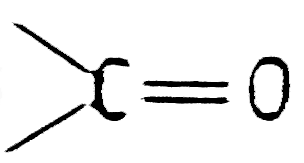Complete Solutions to NCERT FILE (NCERT EXEMPLAR PROBLEMS ) (SHORT ANSWER TYPE QUESTIONS ) of chapter ALDEHYDES ,KETONES AND CARBOXYLIC ACIDS of Class 12 book with complete answers and questions
| Class 12 | CHEMISTRY |
| Chapter | ALDEHYDES ,KETONES AND CARBOXYLIC ACIDS |
| MODERN PUBLICATION | NCERT FILE (NCERT EXEMPLAR PROBLEMS ) (SHORT ANSWER TYPE QUESTIONS ) |
| Number Of Questions | 19 |
| Academic Year | 2023-24 |
Why is there a large difference in the boiling points of butanal and butan-1-ol ?
View SolutionWrite a test to differentiate between pentan-2-one and pentan-3-one.
View SolutionGive the IUPAC names of the following compounds

(iii) ` CH_3 -CH_2 - underset(O ) underset(||)C-CH_2 -CHO`
`(iv ) CH_3 -CH =CH-CHO`
View SolutionGive the structure of the following compounds :
(i) 4-Nitropropiophenone
(ii) 2-Hydroxycyclopentanecarbaldehyde
(iii) Phenyl acetaldehyde.
View SolutionWrite IUPAC names of the following structures .
`(I ){:(CHO),(|),(CHO):}`

View SolutionBenzaldehyde can be obtained from benzalchloride. Write reactions for obtaining benzalchloride and then benzaldehyde from it.
View SolutionName the electrophile produced in the reaction of benzene with benzoyl chloride in the presence of anhydrous `AlCl_(3)`. Name the reaction also.
View SolutionOxidation of ketones involves carbon-carbon bond cleavage. Name the products formed on oxidation of 2, 5-dimethylhexan-3-one.
View SolutionArrange the following in decreasing order of their acidic strength and give reason for your answer.
`CH_(3)CH_(2)OH, CH_(3)COOH, ClCH_(2)COOH, FCH_(2)COOH, C_(6)H_(5)CH_(2)COOH`
View SolutionWhat product will be formed on reaction of propanal with 2-methylpropanal in the presence of NaOH? Write the name of the reaction also.
View SolutionCompound 'A' is prepared by oxidation of compound 'B' with alkaline `KMnO_(4)`. Compound 'A' on reduction with lithium aluminium hydride gets converted back to compound 'B'. When compound 'A' is heated with compound 'B' in the presence of `H_(2)SO_(4)`, it produces fruity smell of compound 'C'. To which family, the compounds 'A', 'B' and 'C' belong to ?
View SolutionArrange the following in decreasing order of their acidic strength. Give explanation for the arrangement.
`C_(6)H_(5)COOH, FCH_(2)COOH, NO_(2)CH_(2)COOH`
View SolutionAlkenes
 and carbonyl compounds
and carbonyl compounds  both contain a `pi` bond but alkenes show electrophilic addition reactions whereas carbonyl compounds show nucleophilic addition reactions. Explain.
both contain a `pi` bond but alkenes show electrophilic addition reactions whereas carbonyl compounds show nucleophilic addition reactions. Explain.
View SolutionCarboxylic acids contain carbonyl group but do not show the nucleophilic addition reactions like aldehydes or ketones. Why?
View SolutionIdentify the compounds A, B and C in the following reaction :
`CH_(3)-Broverset(Mg//ether)rarr(A)overset((i)CO_(2))underset((i)"Water")rarr(B)overset(CH_(3)OH//H)underset(Delta)rarr(C)`
View SolutionWhy are carboxylic acids more acidic than alcohols or phenols although all of them have hydrogen atom attached to a oxygen atom (-O-H)?
View SolutionComplete the following reaction sequence
` CH_3 - overset(O ) overset(|| )C-CH_3 underset((ii ) H_2 O) overset((i) CH_3 Mg Br) to (A) underset("Ether ") overset("Na metal ") to (B ) overset(CH_3 -Br) to ( C)`
View SolutionEthylbenzene is generally prepared by acetylation of benzene followed by reduction and not by the direct alkylation of benzene. Think of a possible reason.
View SolutionCan Gattermann-Koch reaction be considered similar to Friedel Craft's acylation ? Discuss.
View Solution
NCERT FILE (NCERT EXEMPLAR PROBLEMS ) (SHORT ANSWER TYPE QUESTIONS ) questions and complete solutions for chapter ALDEHYDES ,KETONES AND CARBOXYLIC ACIDS of MODERN PUBLISHERS CHEMISTRY (HINGLISH) of Class 12
All Exercises from MODERN PUBLICATION Class 12 CHEMISTRY ALDEHYDES ,KETONES AND CARBOXYLIC ACIDS
- COMPETITION FILE ( OBJECTIVE TYPE QUESTIONS - MULTIPLE CHOICE QUESTIONS (MCQ) ( A. MULTIPLE CHOICE QUESTIONS )
- COMPETITION FILE ( OBJECTIVE TYPE QUESTIONS - MULTIPLE CHOICE QUESTIONS (MCQ) ( B. MULTIPLE CHOICE QUESTIONS )
- COMPETITION FILE ( OBJECTIVE TYPE QUESTIONS - MULTIPLE CHOICE QUESTIONS (MCQ) ( C. MULTIPLE CHOICE QUESTIONS )
- COMPETITION FILE ( OBJECTIVE TYPE QUESTIONS - MULTIPLE CHOICE QUESTIONS (MCQ) ( D. MULTIPLE CHOICE QUESTIONS )
- COMPETITION FILE ( OBJECTIVE TYPE QUESTIONS - MULTIPLE CHOICE QUESTIONS (MCQ) ( INTEGER TYPE QUESTIONS )
- Conceptula Questions 1
- Conceptula Questions 2
- EXAMPLE
- HOTS HIGHER ORDER THINKING SKILLS
- NCERT FILE (NCERT EXEMPLAR PROBLEMS ) (MATCHING TYPE QUESTIONS)
- NCERT FILE (NCERT EXEMPLAR PROBLEMS ) (MULTIPLE CHOICE QUESTIONS ( TYPE -I)
- NCERT FILE (NCERT EXEMPLAR PROBLEMS ) (MULTIPLE CHOICE QUESTIONS ( TYPE -II)
- NCERT FILE (NCERT EXEMPLAR PROBLEMS ) (SHORT ANSWER TYPE QUESTIONS )
- NCERT FILE (NCERT IN TEXT QUESTIONS )
- NCERT FILE (NCERT TEXTBOOK EXERCISES )
- PRACTICE PROBLEMS
- QUICK MEMORY TEST ( A. SAY TRUE OR FALSE )
- QUICK MEMORY TEST ( B. COMPLETE THE MISSING LINKS )
- QUICK MEMORY TEST ( C. CHOOSE THE CORRECT ALTERNATIVE )
- REVISION EXERCISES (OBJECTIVE QUESTIONS - ASSERTION REASON QUESTIONS )
- REVISION EXERCISES (OBJECTIVE QUESTIONS - LONG ANSWER QUESTIONS )
- REVISION EXERCISES (OBJECTIVE QUESTIONS - MULTIPLE CHOICE QUESTIONS )
- REVISION EXERCISES (OBJECTIVE QUESTIONS - PASSAGE BASED QUESTIONS )
- REVISION EXERCISES (OBJECTIVE QUESTIONS - SHORT ANSWER QUESTIONS )
- REVISION EXERCISES (OBJECTIVE QUESTIONS - VERY SHORT ANSWER QUESTIONS )
- UNIT PRACTICE TEST